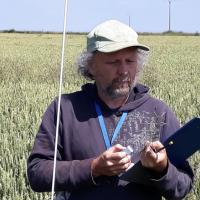
Biodiversity Reading time 5 min
Weeds: To love or not to love?
Published on 27 June 2018
While Bruno Chauvel was completing his undergraduate degree in ecology in the late eighties, he was considering studying plant communities. But during an internship at INRA’s Weed Science unit in Dijon, he discovered weeds and quickly turned his attention to agricultural research. In the early nineties, the first questions were being raised about the environmental toxicity and reduced effectiveness of herbicides related to target plants’ resistance to these products. Bruno directed his interest in population genetics into his thesis, which compared black-grass populations that were resistant and sensitive to herbicides.
Plants that have survived since the beginning of agriculture
For 8,000 years, weeds have been a part of all human activities
The Weed Science unit eventually changed its name to the Biology and Weed Management unit while Bruno moved up the ranks from researcher to research director. But he is still studying these plants that have been “annoying” farmers since the beginning of agriculture. “The most bothersome species have changed and their impact has varied over time: wild mustard subsided decades ago, black-weed and thistles continue to be a problem and ragweed has recently gotten worse,” says Bruno. “But they are always the weeds with a growing cycle similar to crops, because management options that don’t destroy crops are limited.”
Reasonable and responsible weeding practices
When he came to INRA in 1993, Bruno’s research was focused on the impact of cropping systems on weed populations. “We were trying to find ways to remove weeds from plots using the least amount of herbicides possible and promote alternative practices,” he explains. “We were working on integrated weeding based on tilling and combining methods such as crop rotation or targeted weed control.” Bruno and his team regularly looked to other weed experts to improve their own knowledge. “We conducted trials with farmers and spent a lot of time talking to them to understand how our approach was working and what was going on in the fields.” Recently, within the Agroecology unit (1), Bruno participated in a study on how farming management impacts weeds. “Today, managing these plants is no longer happening on a plot-by-plot basis, but rather across the landscape. Hedges, grassy borders and fallow land with wildflowers can recreate an ecosystem where weeds are less aggressive for farmers, allowing them to use lower amounts of herbicides.”
Ragweed: an invasive and highly allergenic species!
Weeds can prove tricky to get under control. Bruno spends a lot of time studying invasive species such as ragweed. “I’ve looked for the ‘strengths’ in invasive plants that tolerate weeding practices to get the better of them,” he says. Ragweed is particularly tenacious: its seed lifetime in soil exceeds that of crop rotation and it is able to withstand all types of stresses well. “It’s a tough problem to solve! Farmers sometimes have to stop growing a certain crop, which can cause financial difficulties. They also need to weed fields as late as possible, but to prevent pollen allergies – which are rising – it’s actually best to weed early, which can result in health and social issues.”
Since 2011, Bruno has regularly lent his expertise to national and European consultations on ragweed control, and he was the French representative for the European COST-SMARTER project. “Among the different ecologists and specialists in biological control, I provided an agricultural and French perspective, where this highly allergenic species is a real challenge.” An as expert for the ANSES (2), he has worked with doctors on crucial health issues related to ragweed. “Ragweed has given me an opportunity to learn about completely different scientific cultures. It’s one of the most interesting aspects!” Until 2016, Bruno coordinated the Ragweed Observatory created by the French Ministry for Health and INRA to promote ragweed control.
(1) Agroecology Joint Research Unit (Inra-AgroSup Dijon-University of Burgundy-CNRS), Bourgogne-Franche-Comté Inra centre
(2) French Agency for Food, Environmental and Occupational Health & Safety
- 55 years old
- Married with two children
- 2014: Authorisation to conduct research: Benefits of agricultural sciences and ecology in integrated pest management (Apports de l'agronomie et de l'écologie pour une gestion intégrée des communautés de mauvaises herbes)
- 1993: Joined INRA in Dijon.
- 1991: PhD in Ecology. Thesis: Genetic polymorphism and selection for resistance to substituted urea herbicides in Alopecurus myosuroides Huds (Polymorphisme génétique et sélection de la résistance aux urées substituées chez Alopecurus myosuroides Huds).
- 1987: Undergraduate degree in Ecology with a specialisation in Phytosociology
